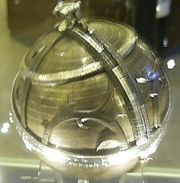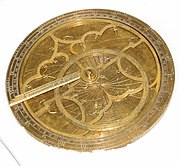Astrolabe
From Wikipedia, the free encyclopedia

An astrolabe is a historical astronomical instrument used by classical astronomers, navigators, and astrologers. Its many uses include locating and predicting the positions of the Sun, Moon, planets, and stars; determining local time given local latitude and vice-versa; surveying; and triangulation.
In the medieval Islamic world, they were used primarily for astronomical studies, as well as in other areas as diverse as astrology, navigation, surveying, timekeeping, Salah prayers, and Qibla. Astrologers of the European nations used astrolabes to construct horoscopes.
There is often confusion between the astrolabe and the mariner's astrolabe. While the astrolabe could be useful for determining latitude on land, it was an awkward instrument for use on the heaving deck of a ship or in wind. The mariner's astrolabe was developed to address these issues.
Contents |
[edit] A Brief History
An early rudimentary astrolabe was invented in the Hellenistic world in either the first or second centuries BC and is often attributed to Hipparchus. A marriage of the planisphere and dioptra, the astrolabe was effectively an analog calculator capable of working out several different kinds of problems in spherical astronomy. Theon of Alexandria wrote a detailed treatise on the astrolabe, and Lewis (2001) argues that Ptolemy used an astrolabe to make the astronomical observations recorded in the Tetrabiblos.[1]
Brass astrolabes (Arabic: اسطرلاب asterlab, ostorlab) were developed in the medieval Islamic world, chiefly as an aid to navigation and as a way of finding the qibla, the direction of Mecca. The first person credited with building the astrolabe in the Islamic world is reportedly the eighth century mathematician, Muhammad al-Fazari.[2] The mathematical background was established by the Arab astronomer, Muhammad ibn Jābir al-Harrānī al-Battānī (Albatenius), in his treatise Kitab az-Zij (ca. 920 AD), which was translated into Latin by Plato Tiburtinus (De Motu Stellarum). The earliest surviving astrolabe is dated AH 315 (927/8 AD). In the Islamic world, astrolabes were used to find the times of sunrise and the rising of fixed stars, to help schedule morning prayers (salat). In the 10th century, al-Sufi first described over 1,000 different uses of an astrolabe, in areas as diverse as astronomy, astrology, horoscopes, navigation, surveying, timekeeping, prayer, Salah, Qibla, etc.[3]
Abū Ishāq Ibrāhīm al-Zarqālī (Arzachel) of Al-Andalus constructed the first universal astrolabe instrument which, unlike its predecessors, did not depend on the latitude of the observer, and could be used from anywhere on the Earth. This instrument became known in Europe as the "Saphaea". The astrolabe was introduced to other parts of Europe via Al-Andalus in the 11th century.[4] Early Christian recipients of Arab astronomy included Gerbert of Aurillac and Hermannus Contractus.
The spherical astrolabe, a variation of both the astrolabe and the armillary sphere, was invented during the Middle Ages by astronomers and inventors in the Islamic world.[5] The earliest description of the spherical astrolabe dates back to Al-Nayrizi (fl. 892-902). In the 12th century, Sharaf al-Dīn al-Tūsī invented the linear astrolabe, sometimes called the "staff of al-Tusi", which was "a simple wooden rod with graduated markings but without sights. It was furnished with a plumb line and a double chord for making angular measurements and bore a perforated pointer."[6] The first geared mechanical astrolabe was later invented by Abi Bakr of Isfahan in 1235.[7]
Peter of Maricourt in the last half of the thirteenth century also wrote a treatise on the construction and use of a universal astrolabe (Nova compositio astrolabii particularis). However, given the complicated nature of the instrument, it is highly unlikely that any were actually constructed; at least none survive.
The English author Geoffrey Chaucer (ca. 1343–1400) compiled a treatise on the astrolabe for his son, mainly based on Messahalla. The same source was translated by the French astronomer and astrologer Pelerin de Prusse and others. The first printed book on the astrolabe was Composition and Use of Astrolabe by Cristannus de Prachaticz, also using Messahalla, but relatively original.
In 1370, the first Indian treatise on the astrolabe was written by the Jain astronomer Mahendra Suri.[8]
The first known European metal astrolabe was developed in the fifteenth century by Rabbi Abraham Zacuto in Lisbon. Metal astrolabes improved on the accuracy of their wooden precursors. In the fifteenth century, the French instrument-maker Jean Fusoris (ca. 1365–1436) also started selling astrolabes in his shop in Paris, along with portable sundials and other popular scientific gadgets of the day.
In the 16th century, Johannes Stöffler published Elucidatio fabricae ususque astrolabii, a manual of the construction and use of the astrolabe. Four identical 16th century astrolabes made by Georg Hartmann provide some of the earliest evidence for batch production by division of labor.
[edit] Astrolabes and clocks
At first mechanical astronomical clocks were influenced by the astrolabe; in many ways they could be seen as clockwork astrolabes designed to produce a continual display of the current position of the sun, stars, and planets. Ibn al-Shatir constructed the earliest astrolabic clock in the early 14th century.[9] At around the same time, Richard of Wallingford's clock (c. 1330) consisted essentially of a star map rotating behind a fixed rete, similar to that of an astrolabe.[10]
Many astronomical clocks, such as the famous clock at Prague, use an astrolabe-style display, adopting a stereographic projection (see below) of the ecliptic plane.
In 1985 Swiss watchmaker Dr. Ludwig Oechslin designed and built an astrolabe wristwatch in conjunction with Ulysse Nardin.
[edit] Construction
An astrolabe consists of a hollow disk, called the mater (mother), which is deep enough to hold one or more flat plates called tympans, or climates. A tympan is made for a specific latitude and is engraved with a stereographic projection of circular lines of equal azimuth and altitude representing the portion of the celestial sphere which is above the local horizon. The rim of the mater is typically graduated into hours of time, or degrees of arc, or both. Above the mater and tympan, the rete, a framework bearing a projection of the ecliptic plane and several pointers indicating the positions of the brightest stars, is free to rotate. Some astrolabes have a narrow rule or label which rotates over the rete, and may be marked with a scale of declinations.
The rete, representing the sky, has the function of a star chart. When it is rotated, the stars and the ecliptic move over the projection of the coordinates on the tympan. A complete rotation represents the passage of one day. The astrolabe is therefore a predecessor of the modern planisphere.
On the back of the mater there will often be engraved a number of scales which are useful in the astrolabe's various applications; these will vary from designer to designer, but might include curves for time conversions, a calendar for converting the day of the month to the sun's position on the ecliptic, trigonometric scales, and a graduation of 360 degrees around the back edge. The alidade is attached to the back face. An alidade can be seen in the lower right illustration of the Persion astrolabe above. When the astrolabe is held vertically, the alidade can be rotated and a star sighted along its length, so that the star's altitude in degrees can be read ("taken") from the graduated edge of the astrolabe; hence "astro" = star + "labe" = to take.
[edit] See also
| Wikimedia Commons has media related to: Astrolabe |
- Antikythera mechanism
- Armillary sphere
- Astrarium
- Astronomical clock
- Cosmolabe
- Equatorium
- Islamic astronomy
- Orrery
- Planetarium
- Prague Orloj
- Sextant (astronomical)
- Sharafeddin Tusi, the inventor of the linear astrolabe
- Torquetum
[edit] Notes
- ^ Evans (1998:155) "The astrolabe was in fact an invention of the ancient Greeks."
Krebs & Krebs (2003:56) "It is generally accepted that Greek astrologers, in either the first or second centuries BC, invented the astrolabe, an instrument that measures the altitude of stars and planets above the horizon. Some historians attribute its invention to Hipparchus" - ^ Richard Nelson Frye: Golden Age of Persia. p. 163
- ^ Dr. Emily Winterburn (National Maritime Museum), Using an Astrolabe, Foundation for Science Technology and Civilisation, 2005.
- ^ M. T. Houtsma and E. van Donzel (1993), E. J. Brill's First Encyclopaedia of Islam, Brill Publishers, ISBN 9004082654
- ^ Emilie Savage-Smith (1993). "Book Reviews", Journal of Islamic Studies 4 (2), p. 296-299.
"There is no evidence for the Hellenistic origin of the spherical astrolabe, but rather evidence so far available suggests that it may have been an early but distinctly Islamic development with no Greek antecedents."
- ^ O'Connor, John J.; Robertson, Edmund F., "Sharaf al-Din al-Muzaffar al-Tusi", MacTutor History of Mathematics archive
- ^ Silvio A. Bedini, Francis R. Maddison (1966). "Mechanical Universe: The Astrarium of Giovanni de' Dondi", Transactions of the American Philosophical Society 56 (5), p. 1-69.
- ^ Glick et al., eds. (2005). Medieval Science, Technology, and Medicine: An Encyclopedia. Routledge. pp. 464. ISBN 0415969301.
- ^ David A. King (1983). "The Astronomy of the Mamluks", Isis 74 (4), p. 531-555 [545-546].
- ^ John David North, "God's Clockmaker: Richard of Wallingford and the Invention of Time", Continuum International Publishing Group, 2005, ISBN 978-1852854515
[edit] References
- Evans, James (1998), The History and Practice of Ancient Astronomy, Oxford University Press, ISBN 0195095391.
- Alessandro Gunella and John Lamprey, Stoeffler's Elucidatio (translation of Elucidatio fabricae ususque astrolabii into English). Published by John Lamprey, 2007. lamprey@frii.com
- Krebs, Robert E.; Krebs, Carolyn A. (2003), Groundbreaking Scientific Experiments, Inventions, and Discoveries of the Ancient World, Greenwood Press.
- Lewis, M. J. T. (2001), Surveying Instruments of Greece and Rome, Cambridge University Press.
- John North. God's Clockmaker, Richard of Wallingford and the invention of time. Hambledon and London, 2005.
- Critical edition of Pelerin de Prusse on the Astrolabe (translation of Practique de Astralabe). Editors Edgar Laird, Robert Fischer. Binghamton, New York, 1995, in Medieval & Renaissance Texts & Studies. ISBN 0-86698-132-2
- King, Henry Geared to the Stars: the evolution of planetariums, orreries, and astronomical clocks University of Toronto Press, 1978
[edit] External links
- The Astrolabe
- Keith's Astrolabe, a software astrolabe simulator and tutorial written in Java
- A working model of the Dr. Ludwig Oechslin's Astrolabium Galileo Galilei watch
- Ulysse Nardin Astrolabium Galilei Galileo: A Detailed Explanation
- Fully illustrated online catalogue of world's largest collection of astrolabes
- Gerbert d'Aurillac's use of the Astrolabe at Convergence
|
||||||||||||||||||||





